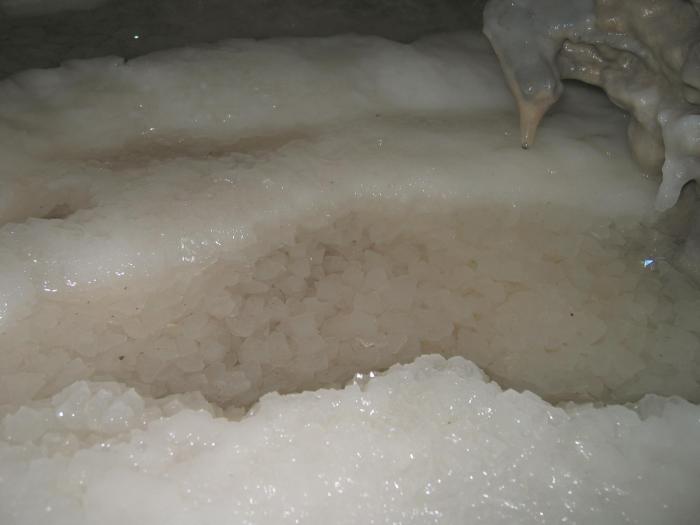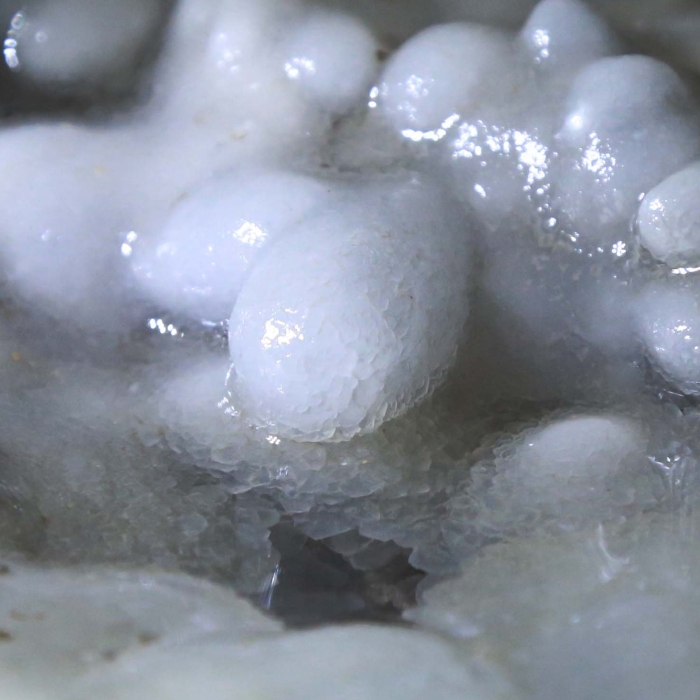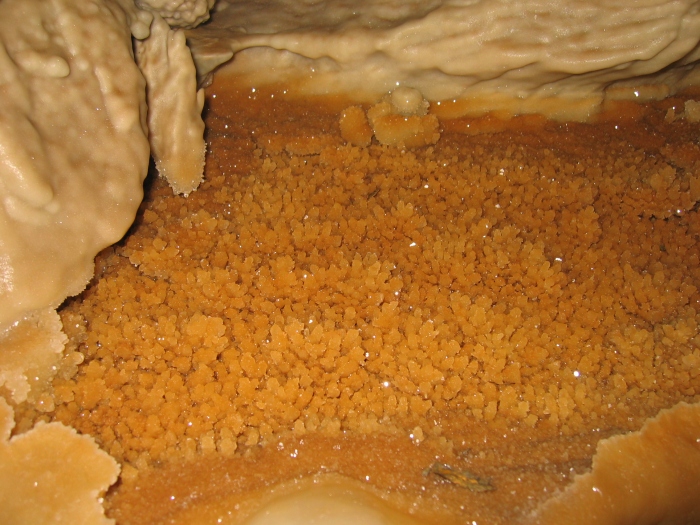English below.

Cristalli in accrescimento nel Ramo dei Tre
Growing Crystals in the Branch of the Three
In tutte le zone più concrezionate della Grotta del Vento si possono osservare minuscoli laghetti dall’acqua immobile che riflettono come specchi l’ambiente sovrastante. Osservandoli con attenzione si può osservare che mentre le concrezioni che li circondano hanno una superficie liscia e lucente, il fondo e le pareti di queste pozze appaiono molto scabre in quanto sono completamente rivestite da un letto di cristalli di calcite che possono arrivare a dimensioni centimetriche.

Cristalli in accrescimento e concrezioni da splash nella Sala del Ciondolo Growing Crystals and splash formations in the Pendant room
In alcuni casi le pozze sono asciutte e mostrano più evidenti le cristallizzazioni di calcite, la cui crescita si è definitivamente arrestata. Nelle pozze allagate i cristalli sono invece ancora in fase di crescita. La forma dei cristalli è complessa e varia e, nonostante sia possibile distinguere diverse facce, quasi mai si possono riconoscere la forma del romboedro che è tra le più comini in questo minerale. Si notano invece distintamente dei folti aggregati scalenoedri in una piccola pozza asciutta situata nella Galleria dei Drappeggi.

Grossi cristalli nel Ramo dei Tre – Large Crystals in the Branch of the Three

Cristalli scalenoedrici asciutti nella Galleria dei Drappeggi – Dry scalenohedron Crystals in the Tunnel of Draperies
La formazione dei cristalli è dovuta alla fuga dalla superficie dell’acqua di anidride carbonica che si disperde nell’aria della grotta. Essa determina la trasformazione del bicarbonato di calcio disciolto in carbonato di calcio, che cristallizza all’interno della pozza rivestendone il fondo e le pareti. Più l’acqua è ferma, più i cristalli possono crescere con regolarità assumendo forme geometriche e dimensioni considerevoli. Dove l’acqua è mossa, ad esempio, dallo stillicidio, le dimensione dei cristalli risultano in gerere assai ridotte, come nelle pozze che fiancheggiano il Lago dei Cristalli, dove appaiono come masse spugnose grigie, opache e indistinte.
La calcite subacquea può arrivare a rivestire in tempi relativamente brevi qualunque oggetto che cade nelle pozze, come frammenti di stalattiti, pietre, o addirittura monete lasciate cadere dai visitatori.
Il colore può variare dal bianco traslucido al giallo ed al rossastro. Alcuni aggregati cristallini sono caratterizzati da una trasparenza che può ricordare quella del quarzo.
UNDERWATER CRYSTALS OF CALCITE
In all the areas with many formations in the Grotta del Vento minute pools of motionless water can be seen which reflect like mirrors the surroundings below. Looking closely at them one can observe that while the formations which surround them have a smooth shiny surface, the bottom and the sides of these pools appear much rougher since they are completely covered by a bed of calcite crystals which can get to a few centimetres in size.
In some cases the pools are dry and the crystallization of the calcite, whose growth has stopped, is more evident. In the pools filled with water the crystals are still growing. The shape of the crystals is complex and varied and, although it is possible to distinguish different sides, the diamond shape can almost never be recognized which is the most common shape for this mineral. Big groups of scalenohedron calcite can distinctly be seen in a small pool in the Tunnel of Draperies.
The formation of the crystals is caused by the release from the surface of the water of carbon dioxide which disperses into the air of the cave. This determines the transformation of dissolved calcium bicarbonate into calcium carbonate, which crystallizes inside the pool coating the bottom and sides. The stiller the water, the more the crystals can grow with regularity assuming geometrical shapes and considerable dimensions. Where the water is moving, for example, from the dripping, the dimensions of the crystals are much smaller, such as in the pools which flank the Crystal Lake, where they appear as indistinct, dull, spongy grey masses.
The underwater calcite can coat in a relatively fast time any object that falls into the pools, such as fragments of stalactites, stones, or even coins dropped by visitors.
The colour can vary from translucent white to yellow to red. Some groups of crystals are characterized by a transparency that reminds that of quartz.


